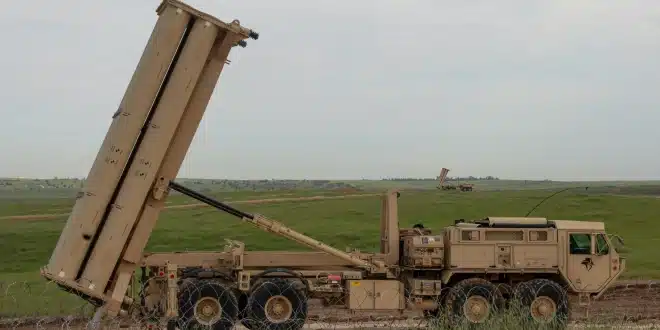The THAAD defense system is one of the U.S. military’s most advanced anti-missile weapons, designed to intercept ballistic missiles at distances ranging from 150 to 200 kilometers (93 to 124 miles) with an exceptional success rate during testing.
Known as the Terminal High-Altitude Area Defense (THAAD), this system utilizes sophisticated radar and interceptor technology, making it the only U.S. missile defense system capable of engaging and neutralizing short, medium, and intermediate-range ballistic missiles both inside and outside Earth’s atmosphere during their terminal flight phase. THAAD interceptors are non-explosive, destroying incoming missiles through direct impact.
According to a Congressional Research Service report, the U.S. military operates seven THAAD batteries. Each battery includes six truck-mounted launchers (equipped with eight interceptors each), a powerful radar system, and a fire control and communications unit.
One of these THAAD batteries is being sent to Israel to strengthen its missile defense capabilities following Iran’s missile attacks on Israel on April 13 and October 1, as reported by the Pentagon. The deployment will involve around 100 U.S. troops on the ground to operate the system.
THAAD systems are designed to integrate seamlessly with other U.S. missile defenses, such as the Aegis systems aboard Navy ships and Patriot missile defense systems, further enhancing Israel’s defense capabilities. The decision to send THAAD reflects the Biden administration’s emphasis on protecting Israel from further missile threats.
While the Pentagon has not specified when THAAD will become operational in Israel, the system can be rapidly deployed by Air Force cargo planes like the C-17 and C-5.
One key to THAAD’s precision is its advanced radar system, the AN/TPY-2, which can detect and track missiles at ranges of up to 3,000 kilometers (1,865 miles) in its forward-based mode. This radar can also track missiles during their descent in terminal mode. Since Israel is approximately 1,700 kilometers (1,100 miles) from Iran, THAAD’s capabilities make it a vital asset in Israel’s defense.
THAAD’s deployment is expected to work in conjunction with Israel’s existing missile defense systems, adding another layer of protection. Military analyst Cedric Leighton described THAAD as a “deterrent” that will bolster Israel’s air and missile defense network.
Israel already possesses multiple missile defense systems, such as David’s Sling, which can intercept targets up to 300 kilometers away using Stunner and SkyCeptor interceptors. Additionally, Israel’s Arrow 2 and Arrow 3 systems, co-developed with the U.S., are designed to take down ballistic missiles during their terminal and space-based phases, respectively. The Iron Dome serves as the defense against short-range projectiles with its 10 batteries and mobile missile launchers.
This isn’t the first time the U.S. has sent a THAAD battery to Israel, with a similar deployment occurring in 2019 for training exercises. Globally, THAAD deployments are closely monitored by U.S. rivals. For instance, China expressed strong opposition to the THAAD deployment in South Korea in 2017, concerned that the radar could be used to monitor activities deep inside China. The U.S. has also stationed THAAD systems in Guam to protect military bases there from potential missile threats from North Korea or China.


